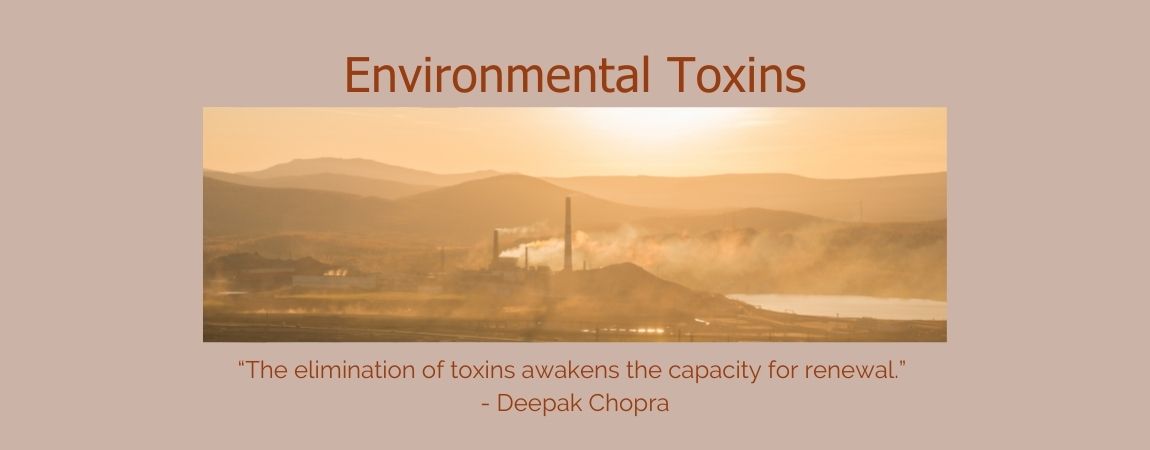How do you like your environmental toxins?
Nature has equipped us with a body that is excellent at getting rid of substances it doesn’t need or that would harm it. It does this without any effort on our part and without us even being aware. For millennia, such substances were mainly waste and by-products of our metabolism. Although environmental toxins have always existed, the toxic load we are exposed to due to human activity on the planet has been increasing exponentially.
Environmental toxins are everywhere
We can’t see, smell, or taste them, yet environmental toxins are everywhere around us in our modern world. In fact, they are the price we pay for the abundance, convenience and the many ‘good’ things in life we have become accustomed to. The air we breathe is polluted by soot particles, fine dust, nitrogen oxides and many other substances from industry and transport. At home and at work, our bodies are exposed to pollutants from wall paints, wood treatments, flooring, insulation materials, toys, textiles, detergents, hygiene products and cosmetics. We can safely assume that every one of us bears a – greater or lesser – load of environmental toxins that we expect our bodies to deal with. We just don’t usually know about it.
Unfortunately, there is hardly any food today that is not contaminated in some way. Grains, fruit and vegetables are grown with artificial fertilisers in fields doused in herbicides. The produce is then sprayed with pesticides and, after harvest, chemically treated to increase shelf-life. Drinking water gets filtered, but many substances such as pesticides and hormones remain. Livestock and farmed fish are treated with hormones and antibiotics. Marine animals in the wild absorb mercury and microplastics from the oceans. We have accepted colourings, flavourings, emulsifiers and preservatives in food as normal.
The consequences of toxicity
Many of these substances have been declared ‘safe’, at least up to a certain level.
However, all of them together form a different chemical cocktail within each of us. All the laboratories in the world couldn’t investigate all possible combinations. The vast number and dosages of environmental toxins we are exposed to create a ticking time bomb in every body.
Environmental toxins enter the body via the mucous membranes of the eyes, nose, mouth, lungs, and intestine or via the skin. They leave via the liver, kidneys, lungs and skin. What can’t be detoxified is stored away in the liver or fatty tissues. Considering that our body wasn’t made for the immense toxic load we are exposed to today, it is doing astonishingly well. But there may come the point where your detoxification system gets overwhelmed. If your body struggles to detoxify, toxic chemicals can accumulate, make you ill and cause pain. Chronic fatigue/MA, pain in muscles, tendons and ligaments, auto-immune disease, joint inflammation, chronic hormonal disorders, sexual dysfunction and cancer have been linked to gradual poisoning.
Are we completely powerless?
The most effective step we can take to protect ourselves is to avoid as many toxins as possible. Tobacco, alcohol, caffeine and recreational drugs should be avoided to give the detoxifying organs some relief.
Buy as much organic food as you can afford. If you have to prioritise, consider that, collectively, grains have a large surface area compared to, say, a melon, and therefore have a higher pesticide load. Also, delicate, soft fruit and vegetable, such as berries or spinach, are often treated with chemicals to protect them. Apples, celery and potatoes are more prone to pests than onions, aubergines or cabbage and may get sprayed more heavily. For more information, check out the Dirty Dozen/Clean 15 of the Environmental Working Group. Always wash your produce; soak conventionally produced fruit and vegetables in salt or vinegar water, and peel where appropriate.
The best way to avoid food additives is, of course, to cook from scratch. Then you’ll know exactly what’s in your food.
Read the labels of your personal hygiene and cosmetics packaging. As with food, the shorter the ingredients list, the better. Natural products are hugely popular now, and with just a little research, you will find a brand you like.
When purchasing goods, such as clothes or furniture, check if they come from sustainable sources. Our planet has finite resources, and sustainability has gained some traction in recent years. Interestingly, sustainable products tend to be less toxic, too.
First, you may ask yourself whether you need the item at all. If you decide not to buy, you’re also not bringing the accompanying toxins into your home. If you do need it, you may consider whether you would be comfortable buying it second hand. Clothes that have been washed many times and furniture that has been used for some time have lost many of the chemicals they were once treated with. If you prefer new items, look for natural or perhaps recycled materials that have had minimum treatment.
Of course, we cannot escape all of the chemicals that surround us. But we can give our body a helping hand in detoxification. Food contains the chemicals – nutrients – our organs need to either expel unwanted substances or render them harmless. Top of the list are cruciferous vegetables (the ‘cabbage family’) and onions, which contain the sulphur the liver needs to do its job. Others are ginger, garlic, turmeric, green leafy vegetables and coriander leaves. Again, home cooking is the best way to include a wide range of nutrients helpful for detoxification while at the same time avoiding additives, which would just increase the toxic load.
If you have concerns about your toxic exposure and would like to learn more about avoiding environmental toxins, read my next newsletter, in which I’ll explore their – sometimes unexpected – hiding places. It’s not too late to sign up! Give me a call if you know or suspect that your detoxification processes might be a little sluggish and would like to learn more about how to support them with food and through kinesiology session.

